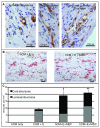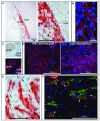Growth of engineered human myocardium with mechanical loading and vascular coculture
- PMID: 21597009
- PMCID: PMC3140796
- DOI: 10.1161/CIRCRESAHA.110.237206
Growth of engineered human myocardium with mechanical loading and vascular coculture
Abstract
Rationale: The developing heart requires both mechanical load and vascularization to reach its proper size, yet the regulation of human heart growth by these processes is poorly understood.
Objective: We seek to elucidate the responses of immature human myocardium to mechanical load and vascularization using tissue engineering approaches.
Methods and results: Using human embryonic stem cell and human induced pluripotent stem cell-derived cardiomyocytes in a 3-dimensional collagen matrix, we show that uniaxial mechanical stress conditioning promotes 2-fold increases in cardiomyocyte and matrix fiber alignment and enhances myofibrillogenesis and sarcomeric banding. Furthermore, cyclic stress conditioning markedly increases cardiomyocyte hypertrophy (2.2-fold) and proliferation rates (21%) versus unconditioned constructs. Addition of endothelial cells enhances cardiomyocyte proliferation under all stress conditions (14% to 19%), and addition of stromal supporting cells enhances formation of vessel-like structures by ≈10-fold. Furthermore, these optimized human cardiac tissue constructs generate Starling curves, increasing their active force in response to increased resting length. When transplanted onto hearts of athymic rats, the human myocardium survives and forms grafts closely apposed to host myocardium. The grafts contain human microvessels that are perfused by the host coronary circulation.
Conclusions: Our results indicate that both mechanical load and vascular cell coculture control cardiomyocyte proliferation, and that mechanical load further controls the hypertrophy and architecture of engineered human myocardium. Such constructs may be useful for studying human cardiac development as well as for regenerative therapy.
Figures








Comment in
-
The beat goes on: human heart muscle from pluripotent stem cells.Circ Res. 2011 Jun 24;109(1):2-4. doi: 10.1161/CIRCRESAHA.111.248039. Circ Res. 2011. PMID: 21700948 No abstract available.
Similar articles
-
Developing vasculature and stroma in engineered human myocardium.Tissue Eng Part A. 2011 May;17(9-10):1219-28. doi: 10.1089/ten.TEA.2010.0557. Epub 2011 Feb 2. Tissue Eng Part A. 2011. PMID: 21187004 Free PMC article.
-
Mechanical Stress Conditioning and Electrical Stimulation Promote Contractility and Force Maturation of Induced Pluripotent Stem Cell-Derived Human Cardiac Tissue.Circulation. 2016 Nov 15;134(20):1557-1567. doi: 10.1161/CIRCULATIONAHA.114.014998. Epub 2016 Oct 13. Circulation. 2016. PMID: 27737958 Free PMC article.
-
Endothelial cell coculture within tissue-engineered cardiomyocyte sheets enhances neovascularization and improves cardiac function of ischemic hearts.Circulation. 2008 Sep 30;118(14 Suppl):S145-52. doi: 10.1161/CIRCULATIONAHA.107.757286. Circulation. 2008. PMID: 18824746
-
Maturing human pluripotent stem cell-derived cardiomyocytes in human engineered cardiac tissues.Adv Drug Deliv Rev. 2016 Jan 15;96:110-34. doi: 10.1016/j.addr.2015.04.019. Epub 2015 May 5. Adv Drug Deliv Rev. 2016. PMID: 25956564 Free PMC article. Review.
-
Trends in cardiovascular engineering: organizing the human heart.Trends Cardiovasc Med. 2013 Nov;23(8):282-6. doi: 10.1016/j.tcm.2013.04.001. Epub 2013 May 27. Trends Cardiovasc Med. 2013. PMID: 23722092 Free PMC article. Review.
Cited by
-
Concise review: cell therapy and tissue engineering for cardiovascular disease.Stem Cells Transl Med. 2012 Feb;1(2):136-41. doi: 10.5966/sctm.2012-0030. Epub 2012 Jan 26. Stem Cells Transl Med. 2012. PMID: 23197760 Free PMC article. Review.
-
Electrophysiological and contractile function of cardiomyocytes derived from human embryonic stem cells.Prog Biophys Mol Biol. 2012 Oct-Nov;110(2-3):178-95. doi: 10.1016/j.pbiomolbio.2012.07.012. Epub 2012 Aug 7. Prog Biophys Mol Biol. 2012. PMID: 22958937 Free PMC article. Review.
-
Biomaterials for pluripotent stem cell engineering: From fate determination to vascularization.J Mater Chem B. 2016 May 28;4(20):3454-3463. doi: 10.1039/C5TB02658J. Epub 2016 Mar 1. J Mater Chem B. 2016. PMID: 27446588 Free PMC article.
-
Cardiac Tissues From Stem Cells: New Routes to Maturation and Cardiac Regeneration.Circ Res. 2021 Mar 19;128(6):775-801. doi: 10.1161/CIRCRESAHA.121.318183. Epub 2021 Mar 18. Circ Res. 2021. PMID: 33734815 Free PMC article. Review.
-
Regeneration in heart disease-Is ECM the key?Life Sci. 2012 Oct 29;91(17-18):823-7. doi: 10.1016/j.lfs.2012.08.034. Epub 2012 Sep 12. Life Sci. 2012. PMID: 22982346 Free PMC article. Review.
References
-
- Montgomery MO, Jiao Y, Phillips SJ, Singh G, Xu J, Balsara R, Litvin J. Alterations in sheep fetal right ventricular tissue with induced hemodynamic pressure overload. Basic Res Cardiol. 1998;93:192–200. - PubMed
-
- Tobita K, Keller BB. Right and left ventricular wall deformation patterns in normal and left heart hypoplasia chick embryos. Am J Physiol Heart Circ Physiol. 2000;279:H959–969. - PubMed
-
- Voronov DA, Alford PW, Xu G, Taber LA. The role of mechanical forces in dextral rotation during cardiac looping in the chick embryo. Dev Biol. 2004;272:339–350. - PubMed
-
- Kira Y, Nakaoka T, Hashimoto E, Okabe F, Asano S, Sekine I. Effect of long-term cyclic mechanical load on protein synthesis and morphological changes in cultured myocardial cells from neonatal rat. Cardiovasc Drugs Ther. 1994;8:251–262. - PubMed
-
- Kuruvilla L, Kartha CC. Molecular mechanisms in endothelial regulation of cardiac function. Mol Cell Biochem. 2003;253:113–123. - PubMed
Publication types
MeSH terms
Grants and funding
LinkOut - more resources
Full Text Sources
Other Literature Sources

